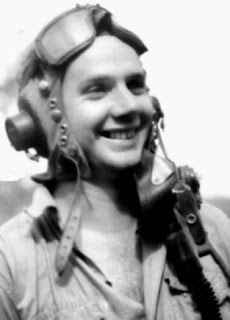Tuesday, January 13, 2015
(402500) Adrian Philip 'Tim' Goldsmith DFC, DFM - 126 Squadron
Spitfire Pilot Tells Of Historic Battle - Goulburn Evening Post 1948. Speaking before the Goulburn Apex Club at its last dinner, Mr. A. P., "Tim" Goldsmith, former R.A.A.F. Spitfire pilot who was awarded the D.F.C. and D.F.M., revealed that during the siege of Malta, petrol was being supplied to the island in four gallon drums from submarines.
Stationed in Malta in 1942, Mr. Goldsmith, who is now a resident of Port Kembla and is well-known in Goulburn, gave a colourful description of activities on the island at the time that it was under the heaviest bombardment of the early war years. His record shows that he has 16 "kills," 8 "probably destroyed," and 7 "damaged" to his credit. Arriving in Malta in February, 1942, the speaker, who had been flying Spitfires in England, was transferred to Hurricanes immediately on arrival. "Petrol was so short on the island that I was given cockpit instruction on the ground, and was told to fly the machine when the alert sounded," he said. "Because of the acute short age of petrol, we were unable to have any training flights, or survey the location of the 'dromes from the ground, Every flight was-an operational movement. "I had one hour 55 minutes flying time in Huricanes and had four combats with the enemy," he added. Emphasising the serious petrol position, the speaker stated that it was not uncommon to see the Governor of Malta, Lord Gort, riding a bicycle to inspect the island's installations. Although they were glad to I receive the petrol in drums, it was not an easy task to fill a Spitfire, with a capacity of 85 I gallons from four gallon tins.
Describing regular German raids on the island, Mr. Goldsmith said the radar equipment would pick up the movement of the bombers, and plans would then be worked out to enable Spitfires and Hurricanes to intercept them, allowing for a minimum wastage of petrol. Once the fighters left the ground it was a matter of attack, and be attacked. In one raid two Spitfires and two Hurricanes were sent up against 88 bombers and 120 fighters. Four J.U.88's and two 109's were shot down, and in the speaker's opinion this must have been one of the most successful air combats of the war. He went on to state that a consignment of new Spitfires had been flown to the island from the Wasp, U.S. Navy carrier. They had been on the 'drome for 10 minutes when the Jerries came over, leaving four undamaged. Later the Eagle had brought 60 Spitfires to the island and in the first combat over 40 German planes had been shot down. This defeat had made the Germans give the matter thought, and as a result they sent over 48 Stuka dive bombers with 200 fighters. A total of 37 of the planes had been shot down. "A Stuka to a Spitfire is like a punter with a system to a bookie," said the speaker, "and that was the last daylight raid by Stukas." In his, address, Mr. Goldsmith gave graphic details of huge shipping losses in the Mediterranean in the early part of the war, and how gradual improvement in air strength had turned the tables.
Subscribe to:
Post Comments (Atom)

No comments:
Post a Comment